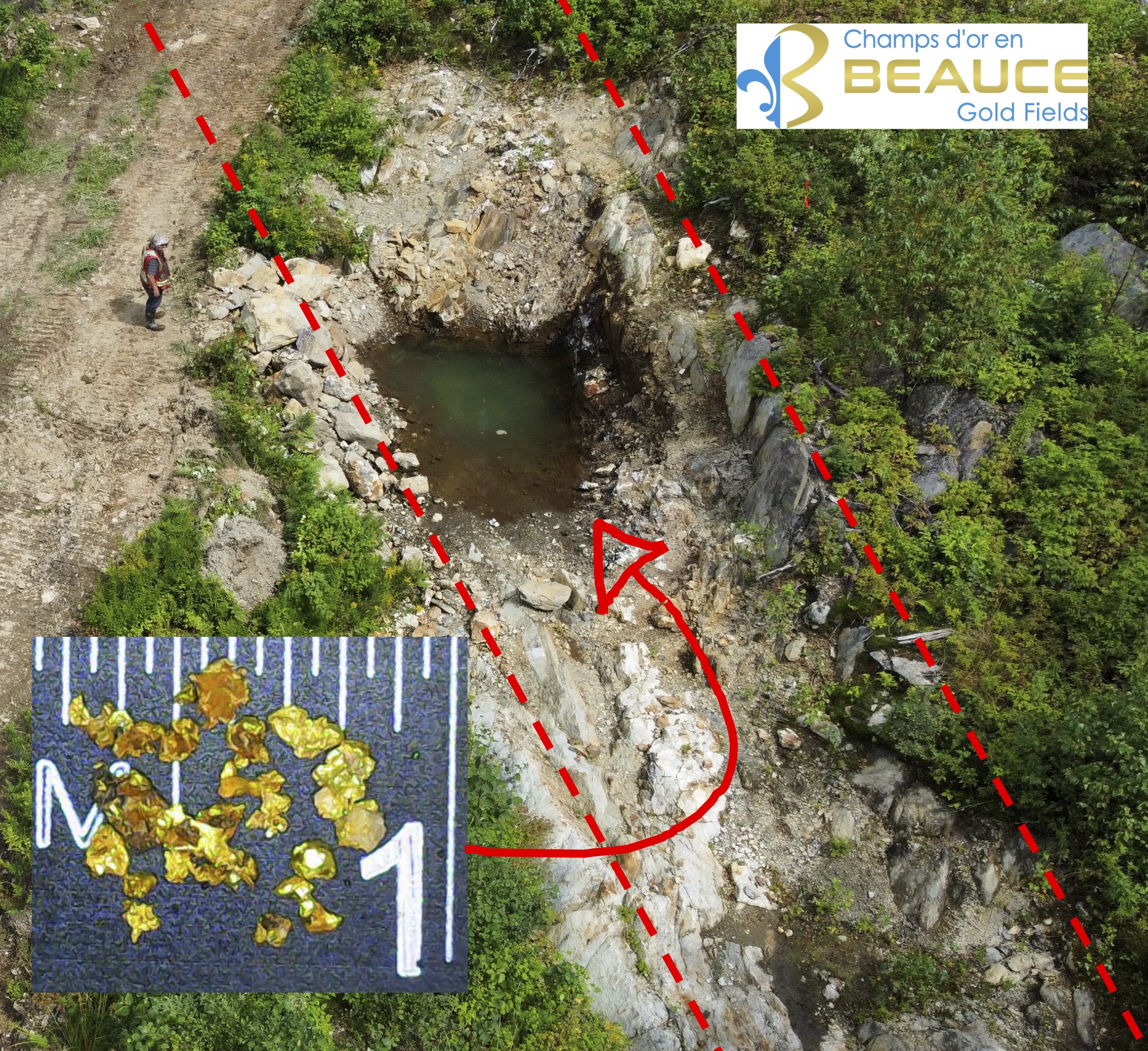Montreal, Quebec — Beauce Gold Fields (Champs D’Or en Beauce) (TSXV: ¨BGF¨), (“BGF”): (“BGF” or the “Company”): referred to as “BGF” or the “Company,” is pleased to announce that it has recovered gold grains from a bulk sample of the Grondin antiform outcrop on the Company’s Beauce Gold property, located in the Beauce region of southern Quebec.
Patrick Levasseur, President and CEO of Beauce Gold Fields, states, “We’ve made a breakthrough discovery in the Beauce’s gold exploration history. Through our diamond drilling and bulk sampling, we’ve unveiled a considerable mineralized structure, extending deep and long, pinpointed as the genesis of the historic placer gold deposits. This structure holds vast promise for further lode gold discoveries.”

Image: Grondin Outcrop Gold Grains, Axis of Antiform
In the summer of 2023 (BGF press release 2023-08-22), the Company undertook a bulk sample of approximately 30 tonnes taken with a backhoe from a mineralized zone within the trench excavated at the Grondin outcrop. The outcrop is part of an exposed Axis of an antiform that the Company has also drilled that summer (BGF press releases, November 1 2023 and January 18 2024). The trench displayed a stockwork featuring a milky white quartz vein of a few meters wide interspersed with pockets sulfide-rich material along shear planes and within boudinage of quartz veins.
The bulked quartz rock, combined with the fractured material, was washed using a mobile placer plant fitted with a trommel and sluice box. This process recovered loose fragments smaller than 10 cm, creating a heavy mineral concentrate, while larger quartz fragments were stored for future crushing and sampling.
The company’s geologist identified over 18 visible and sharply angular grains of gold in the concentrate, underscoring the area’s strong potential for gold generation. Characterized by a robust breccia subsequently intruded by significant stockworks, these formations have intersected two primary lithologies, resulting in intricate networks of interlaced quartz veins and veinlets. The auriferous mineralization noted at the Grondin outcrop was also evident in most of the 2023 drilling activities. The mineralized zone’s envelope may extend up to 10 meters in thickness, with gold closely associated with sulfides located both within the quartz and the host rock. These sulfides, varying from trace amounts to semi-massive clusters, sometimes span several centimeters across. The primary gold-bearing sulfides found at the Grondin showing include fine to microgranular pyrite, sphalerite, and arsenopyrite.
The 2023 initiatives at the Grondin Zone, comprising both bulk processing and drilling, (BGF press releases, November 1 2023 and January 18 2024) met the exploration phase’s initial objectives. Drilling revealed that the Grondin zone extends over 40 meters deep vertically and remains open at depth, with a mineralized structure stretching more than 300 meters in length. This zone is intrinsically linked to an antiform fold axis that spans several kilometers, suggesting that other gold showings may be present along the antiform fold and elsewhere on the Beauce property.
The geology of the Grondin Zone consists of laminated zones and fault mirrors developed in volcanic rock (lapilli tuff) but mainly in black, graphitic, and highly deformed argillite. These significant shearings can lead to a substantial loss of drilling core volume. Ductile deformation affected the mineralized zone, causing boudinage of the quartz veins. The shear faults have greatly facilitated the circulation of mineralizing fluids, particularly along contacts between competent/incompetent rocks. The mineralized rock has been altered by green chlorite and sericite, which make the graphite shiny and silky.
The Company’s diamond drilling and hard rock bulk sampling indicates a significant potential for lode gold discoveries from this gold structure. The gold was found both as sulfides and in free form, suggesting a considerable system likely established northwest of Saint-Simon-les-Mines. This system could have contributed to the development of supergene deposits and extensive auriferous placers in Beauce. Gold that would have been released from the oxidized pyrite, combined with that from visible gold, would have been incorporated into glacial deposits and deposited further downstream towards the southeast from the source.
The Company plans to conduct geophysics along the Grondin structure is confirm it’s dip, depth &length.
Jean Bernard, B,Sc. Geo., is a qualified person, as defined by NI 43-101, who has reviewed and approved the technical information presented in this release.

Beauce Gold Fields is a gold exploration company focused on placer to hard rock exploration in the Beauce region of Southern Quebec.
